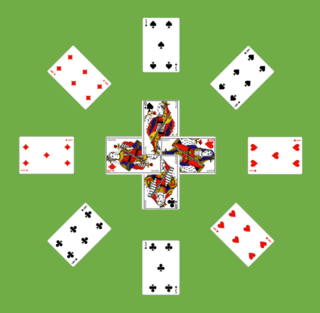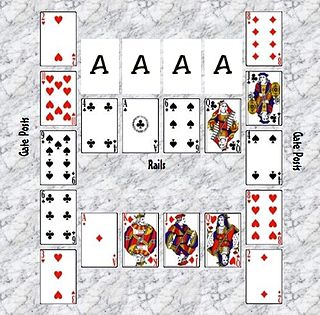Related Research Articles

Games of patience, or (card) solitaires as they are usually called in North America, have their own 'language' of specialised terms such as "building down", "packing", "foundations", "talon" and "tableau". Once learnt they are helpful in describing, succinctly and accurately, how the games are played. Patience games are usually for a single player, although a small number have been designed for two and, in rare cases, three or even four players. They are games of skill or chance or a combination of the two. There are three classes of patience grouped by object.

Quadrille is the name of two loosely related card games of the Patience or solitaire type which are often confused. Both use a pack of 52 playing cards. The earlier one was also known as La Française or Royal Quadrille, the slightly later one as Captive Queens. The name is derived from the desired outcome of the earlier game in which the four Kings and Queens are arranged in a square formation as in the European dance of quadrille that was fashionable in the 18th and 19th centuries.
Royal Cotillion is a solitaire card game which uses two decks of 52 playing cards each. The name probably derives from the fact that since the two kings and two queens of the same suit, the king and queen of each suit dance the cotillion. It has been given the alternate name of Lords and Ladies because if the game is won, the final layout will show the king and queen of each suit together.

Crazy Quilt is a patience or solitaire card game using two decks of 52 playing cards each. The game is so-called because the reserve resembles the weaves of a carpet or an arrangement of a quilt, with cards alternating vertical and horizontal rotations.
St. Helena is a patience or card solitaire game using two decks of playing cards shuffled together. Despite its name, it has no connection to the island with the same name, nor should it be confused with the better known Napoleon at St Helena, also called Forty Thieves in the US.

Diplomat is a patience or solitaire card game which is played using two decks of playing cards shuffled together. Its layout is similar to that of Beleaguered Castle, and the play is similar to Forty Thieves. It can be completed successfully more often than not.
Queen of Italy is a patience or card solitaire game played with two packs of playing cards. It is a very strategic game that rewards careful planning, since the cards that potentially block the game are presented at the start, and with care it can be completed about half the number of attempts.
Duchess or Glenwood is a patience or solitaire card game which uses a deck of 52 playing cards. It has all four typical features of a traditional patience or solitaire game: a tableau, a reserve, a stock or talon and a wastepile. It is relatively easy to get out. It is a reserved packer, the same type of game as Canfield or Demon. Arnold describes it as "an interesting game with a fair chance of a favourable outcome."

Colorado is a solitaire card game which is played using two decks of playing cards. It is a game of card building which belongs to the same family as games like Sir Tommy, Strategy, and Calculation. It is considered an easy game with 80% odds of being completed successfully.

Queen's Audience, sometimes known as King's Audience, is a pictorial patience or solitaire card game which uses a single pack of 52 playing cards. It is so named because the Jacks and their 'entourage' end up adjacent to their respective Queens as if having an audience with them.
Odd and Even is a solitaire card game which is played with two decks of playing cards. It is so called because the building is done in twos, resulting in odd and even numbers.
Deuces or Twos is a patience or card solitaire game of English origin which is played with two packs of playing cards. It is so called because each foundation starts with a Deuce, or Two. It belongs to a family of card games that includes Busy Aces, which is derived in turn from Napoleon at St Helena.
The Plot is a Patience game which is played with two decks of playing cards.

Four Seasons is a patience or card solitaire which is played with a single deck of playing cards. It is also known as Corner Card and Vanishing Cross, due to the arrangement of the foundations and the tableau respectively. Another alternate name is Cross Currents.

Fortune's Favor or Fortune's Favour is a patience or card solitaire which is played with a deck of 52 playing cards. It is so-called probably because the chances of winning are completely on the player's side. It is a significantly simplified version of the game Busy Aces, a member of the Forty Thieves family of solitaire games.
Patriarchs is a patience or card solitaire which is played with two packs of playing cards. It is similar in reserve layout to Odd and Even but with different rules of play.
Contradance is a solitaire card game which is played with two decks of playing cards. It is probably so called because when the game is won, it shows the king and the queen of each suit about to do a dance, the cotillion being a country dance from the 18th century.
Frog is an old French patience or solitaire card game which is played with two decks of playing cards. It belongs to the same family of solitaire games as Strategy, Sir Tommy, Calculation, and Puss in the Corner. Game-play is like Sir Tommy, but with two decks, a fifth waste pile, and a Canfield-like reserve. In its native France it is known as Le Crapaud.
Zodiac is a solitaire card game which is played with two decks of playing cards shuffled together. An old game, it first appeared in Lady Adelaide Cadogan's book Illustrated Games of Patience. It is so-named probably because of its "globe"-shaped layout. It had many variations until its rules were standardized in 1914.

Gate is a patience or card solitaire game played using a pack of 52 playing cards, and is a member of the Canfield family. It gets its name because the cards are laid out in such a way that they form a gate. Average players can expect to win 99% of their games.
References
- ↑ Royal Rendezvous Solitaire Rules, Solitaire Central. Retrieved 15 October 2020.
